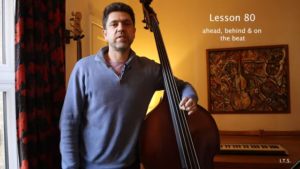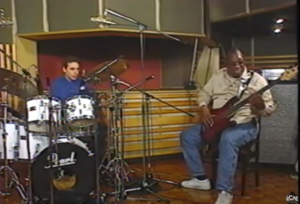CHAPTER 7: TEXTURE, REGISTER AND VOICINGS(テクスチャ、レジスタ、およびボイシング)
Pianists don’t have to put every note in the chord. To find the best possible choice is the thing; four notes can sound like a thousand if they’re the right notes. 47 – Wynton Marsalis
ピアニストはすべての和音にすべての音を入れる必要はありません。最善の選択を見つけることが大切であり、4つの音が正しい音であれば、1000のように聞こえることがあります。 - Wynton Marsalis
Chordal texture(コードのテクスチャ)
The large number of notes available at any given time is both an advantage and a disadvantage to the pianist. Pianists can play chord voicings from small to large in size, with one to ten or more simultaneous notes. In terms of voicing density, the term “chordal texture” describes voicings that are sparse, thin, thick or dense, depending on the number of notes. Accompanists use chordal texture in a variety of ways to sustain the mood of a piece or to adjust to changes of mood as the piece progresses. For example, on “In the Wee Small Hours,” Hobgood employs bare minimum single-note lines rather than solid chords to support Elling. As the piece progresses, Hobgood adds more notes as the lyrics unfold and the musical texture becomes more dense, following the story of the song.
ピアニストにとって、ある時点で利用できる音符の数は利点と欠点の両方です。ピアニストは、1つから10個以上の同時音符を持つ、小さなものから大きなものまでの和音の配置を演奏することができます。和音の密度に関しては、「和音のテクスチャ」という用語が使用され、音符の数に応じて希薄な、薄い、厚い、または濃い配置を表します。伴奏者は、曲のムードを持続させるためや、曲が進行するにつれてムードの変化に適応するために、さまざまな方法で和音のテクスチャを使用します。例えば、「In the Wee Small Hours」では、ホブグッドはエリングをサポートするために、ソリッドな和音ではなく最小限の単音のラインを使用します。曲が進行するにつれて、ホブグッドは歌詞が展開し、音楽のテクスチャがより濃くなるにつれて、より多くの音符を追加し、曲のストーリーに沿っています。
Kurt Elling / Nightmoves - Leaving Again/In The Wee Small Hours 2:40-
The awareness of register(レジスターの意識)
The accompanist must be aware of register and its proper use in order to avoid disturbing the integrity of the vocal line. Chuck Israels warns that staying in the register above the first F or G above middle C for the lead line of accompanying piano chords can be detrimental, as this crowds the acoustic area that singers usually occupy.48 Per Danielson goes further. He feels that in order to fully support the singer, the accompanist must know the quality of the particular voice as well as limits of the register. If the singer has a very soft low register, for example, comping can be sparse and in the mid or upper range.49
伴奏者は、ヴォーカルラインの一体性を損なわないように、レジスターとその適切な使用に気を配る必要があります。チャック・イズラエルは、伴奏ピアノコードのリードラインの最初のFまたはGのレジスター以上に留まることが害になる可能性があるため、これを避けることが重要であると警告しています。 パー・ダニエルソンは更に進んで、伴奏者は特定の声の質とレジスターの制限を知る必要があると感じています。たとえば、歌手の低いレジスターが非常に柔らかい場合、コンピングは疎く、中音域または高音域にすることができます。
Since some melodies and vocalists have wide ranges, it would be impossible for the accompanist to constantly adjust. Rather than continually responding to the vocalist’s register changes, the interviewed pianists adapt a broader approach to register change.
Jacob prefers to use register in an orchestral way, implying the register of the instrument(s) he is imagining in order to complement the voice. He also uses it to trigger inspiration: “When I am drawn to play the same way as before, I change register to force a different direction. I believe that newer is fresher.”
いくつかのメロディや歌手は広い音域を持っているため、伴奏者が常に調整することは不可能です。インタビューされたピアニストたちは、歌手の音域の変化に常に応じるのではなく、より広範なアプローチで音域の変化に適応しています。 ジェイコブは、楽器の音域を想像して声に合わせるために、オーケストラ的な手法で音域を使用することを好んでいます。また、それをインスピレーションの引き金としても使用しています。「以前と同じように演奏することに引かれるとき、異なる方向性を強制するために音域を変えます。新しいものは新鮮だと信じています。」
Larry Dunlap remains aware of range when accompanying a vocalist, and in his opinion, mid-register chords add “a fullness and lushness to the overall sound.” Upper register fills “add sparkle and lead listeners to make associations with other music they have heard, such as Count Basie tunes or older orchestral accompaniments like Mancini’s where upper register fills were often used.”
ラリー・ダンラップは、歌手との伴奏の際に音域に注意を払っており、彼の意見では、中音域の和音は「全体の音に豊かさと華やかさを加えます。」上音域のフィルは、「輝きを加え、リスナーを他の曲との関連付けに導きます。例えば、カウント・ベイシーの曲やマンシーニのような古いオーケストラの伴奏でよく使われる上音域のフィルとの関連付けです。」
Hobgood stresses the importance of awareness of register, but also notes that the accompanist may desire to be in the same register as the vocalist depending on which register the vocalist chooses. He notes that higher voicings tend to be intrusive, even when comping behind horn solos.50 Gunnison also tries to follow and be aware of the vocalist’s register. However, he will sometimes voice a chord so that it surrounds the note being sung, as in the first two chords of “Round Midnight” in Example 5.2.
ホブグッドは、音域の意識の重要性を強調していますが、同時に、伴奏者は歌手が選んだ音域によって、歌手と同じ音域になりたいと望むこともあると指摘しています。彼は、ホーンのソロの後ろでコンピングする際でも、高い音域の配置がしばしば侵入的になる傾向があると述べています。ガニソンもまた、歌手の音域を追いかけ、意識するようにしています。ただし、歌われている音に囲まれるように和音を配置することもあります。例えば、「Round Midnight」の最初の2つの和音(Example 6.2.(5.2はおそらく誤り))のようにです。
Carmen McRae / Carmen Sings Monk - 'Round Midnight
Colianni varies the register when accompanying, but tries never to do so “in a way that diverts focus or becomes a cheap effect on what we’re trying to convey musically. Sometimes, common sense tells you to get up in the high register for particularly delicate moments; or perhaps to roll thunderously in the lower octaves for muscular endings.” For Colianni, there are many levels of coloring and dynamics that are useable “depending on the mood and material and development of the performance.”
コリアーニは伴奏する際に音域を変えますが、決して音楽的な伝達に焦点を逸らしたり、安易な効果になるようにはしません。時には常識的な判断で、特に繊細な瞬間では高い音域に上がることがあります。また、力強い終わりを演出するために低いオクターブで轟音を奏でることもあります。コリアーニにとって、演奏のムードや素材、発展に応じて使用可能な多くの色彩とダイナミクスが存在します。
di Martino notes that, due to the piano’s limited coloristic nature, in comparison to the innumerable nuances capable on a saxophone or trumpet for example, the main way to create contrasting timbres on the instrument is through the use of register. He suggests as an example that “the left hand could be trombones, the right hand could be high winds or strings” and adds that “playing rich in the meat of the piano, the lower to middle register, is where you create the most full support for a vocalist to sing over.”
ディ・マルティノは、ピアノの色彩的な表現が、例えばサックスやトランペットのような数え切れないほどの微妙なニュアンスに比べて限られているため、楽器上で対比する音色を作る主な方法は、音域の使用です。彼は例として、「左手がトロンボーンであり、右手が高音域の管楽器や弦楽器」といった具体的な提案をします。また、「ピアノの音の芯、低音から中音域で豊かに演奏することが、ボーカリストが歌うために最も充実したサポートを作り出す場所です。」とも述べています。
Creating a mood with specific voicings(特定の voicing でムードを作る)
Accomplished accompanists will adjust their voicings to suit the mood inherent in the song they are performing with the vocalist. Moods shift from moment to moment.
The aware pianist uses a variety of harmonic shapes, colors, and voicings to respond to these varying moods. Though tastes are subjective, some of the many available options that produce emotional “colors” include the following:
熟練した伴奏者は、歌手と演奏する曲に固有のムードに合わせて、自身の voicing を調整することがあります。ムードは瞬時に変化します。気づきのあるピアニストは、これらの変化するムードに応じて、様々なハーモニックな形、色、voicing を使用して応答します。好みは主観的ですが、感情的な「色」を生み出すための多くのオプションの一部を以下に示します。
Example 7.1. Sample voicings that evoke subjective emotional “colors.”(主観的な感情的「色」を呼び起こすサンプルの和音配置)

These voicings may be played at a variety of dynamic levels, and with various textures and touches: broken arpeggios in downward, upward or inward directions, staccato and legato touches are some of the many possibilities. For Halberstadt, specific voicings such as the ones in Example 7.1 yield specific emotional results: “Crunchy” voicings (clusters) versus open voicings, pretty versus dissonant, high versus low, crisp versus sustained, loud versus soft, traditional versus modern, all will vary according to what the tune requires.” Halberstadt has a defined voicing vocabulary when working with vocalists. For example, to evoke a “poignant” mood he might use a variation on what has commonly been called the “Kenny Barron voicing.”51 Halberstadt notes, “The original Kenny Barron voicing consists of stacks of fifths in each hand, separated by a half-step, to produce a minor 11th chord. For example a K.B. voicing for Cm11 would be:”
これらのヴォイシングは、さまざまなダイナミックレベルで演奏され、さまざまなテクスチャーやタッチで表現されます。下向き、上向き、内側に向かう形での分割されたアルペジオ、スタッカートやレガートなタッチなど、数多くの可能性があります。ハルバースタットにとって、Example 7.1に示されているような特定のヴォイシングは、特定の感情的な結果をもたらします。「クランチーな」ヴォイシング(クラスター)対開放的なヴォイシング、美しい対不協和な、高い対低い、鮮やかな対持続的な、大きい対小さい、伝統的な対現代的な、どれも曲に要求されるものによって異なるでしょう。ハルバースタットは、ボーカリストと一緒に作業する際に定義されたヴォイシングの語彙を持っています。例えば、「切ない」ムードを引き出すために、彼は一般的に「ケニー・バロン・ヴォイシング」と呼ばれるものの変形を使用することがあります。ハルバースタットは指摘しています。「オリジナルのケニー・バロン・ヴォイシングは、各手に五度のスタックを半音階で分けて、マイナー11thコードを作り出します。例えば、Cm11のためのK.B.ヴォイシングは次のようになります:」
Example 7.2. “Kenny Barron” voicing for Cm11.

Alternatively, Halberstadt likes to separate the fifth-stack by a whole step to produce a “poignant-sounding” major 13#11 voicing:
ハルバースタットは、代わりに五度のスタックをホール・ステップで分離して、切ないようなメジャー13#11の和音を作り出すことが好きだと述べています。
Example 7.3. Variation on the “Kenny Barron” voicing, Cmaj13(#11).

Eric Gunnison also feels that certain voicings influence the mood or color of a piece. He notes: “Fifth-based voicings open up the sound for me. Voicings with multiple dissonances can give the music a very angular feel and enhance the swing feel.” Gunnison uses many tension-filled altered dominant chords in his accompaniment of Carmen McRae on the angular melody and saxophone solo of “Get It Straight” on Carmen Sings Monk.
エリック・ガニソンも、特定のボイシングが曲のムードやカラーに影響を与えると感じています。「第5音に基づくボイシングは、音を開放的にします。複数の不協和音を含むボイシングは、音楽に非常に角ばった感じを与え、スウィング感を高めます。」と彼は語っています。ガニソンは、カーメン・マクレイとの共演で、Carmen Sings Monkの「Get It Straight」での角ばったメロディーとサックスのソロに対して、多くの緊張感のある変更されたドミナントコードを使用しています。
Carmen McRae / Carmen Sings Monk - Get It Straight
According to di Martino, an accompanist must “find the harmonic color that best supports the melody. It’s a close examination that you begin to understand only by playing for a singer.”52 di Martino alternates between many kinds of harmonic shapes when accompanying a vocalist. For him this depends on the character of the tune he is performing and the mood of each moment. For example, for folk-type songs he may use open-fifth voicings to create a spacious, transparent sound.
一方、ディ・マルティーノによると、伴奏者は「メロディを最もサポートするハーモニックカラーを見つける必要があります。シンガーのために演奏することで、理解し始めることができる細かい調査です」と彼は述べています。彼は、ボーカリストの伴奏をするときに多くの種類のハーモニックシェイプを使い分けます。彼にとって、これは演奏する曲の性格や各瞬間のムードによって異なるとのことです。例えば、フォークソングの場合は、開放的な第5音ボイシングを使用して、広々とした透明なサウンドを作り出すことがあります。
Hobgood categorizes all voicings into open and closed positions. In closed position, chord tones are close together. In open position, however, chord tones are spread apart.53 A chord voicing may only have three or four notes in it, but to Hobgood the challenge lies in playing the best notes that imply the harmony.
ホブグッドは、すべてのヴォイシングをオープンな位置とクローズドな位置に分類しています。クローズドな位置では、和音の音程が近くに配置されます。一方、オープンな位置では、和音の音程が広がって配置されます。ホブグッドにとって、和音のヴォイシングには3つまたは4つの音しか含まれていないかもしれませんが、課題はハーモニーを意味する最適な音を演奏することにあると考えています。
Newton summarized his voicing choices by stating: “The song will give you all that information, it will tell you what to do.” Some standards have inherent harmonic qualities that inspire new ideas. He observes that “‘You Go to My Head’ has wonderful possibilities because it changes key so often.” At other times he notes that one can allude to certain harmonies but not necessarily use them overtly. For example, a suspension in a voicing is an effective way to reinforce an unresolved feeling presented by the vocalist.
By not directly emphasizing chord tones, tension in the lyrics can be underscored and increased. On “By Myself” from Let Yourself Go, at 0:19 on the words “by myself” Newton suspends the 3rd of the chord on C7, emphasizing an F, the fourth of the chord, before resolving to the third. On the word “romance,” Newton surrounds the third entirely before resolving the chord by first playing the F, the 4th, then the D, the Eb, the flatted third, then finally the E natural, or natural third. The feeling of tension and release is fully experienced along with the lyrics, and the song’s story of the end of romance is fully felt.
ニュートンは、ヴォイシングの選択について以下のようにまとめました。「曲自体がすべての情報を提供してくれます。何をすべきか、教えてくれます。」いくつかのスタンダード曲は、新しいアイデアを生み出すような固有のハーモニックな特性を持っています。彼は「『You Go to My Head』はキーが頻繁に変わるため、素晴らしい可能性を秘めています。」と述べています。他の場合では、特定のハーモニーを暗示することもできますが、必ずしも明示的に使用する必要はありません。例えば、ヴォイシングにおけるサスペンションは、ヴォーカリストによって提示された未解決の感情を強調する効果的な方法です。 和音の音程を直接的に強調しないことで、歌詞の緊張感を強調し、増大させることができます。例えば、Let Yourself Goの「By Myself」では、0:19の「by myself」というフレーズで、ニュートンはC7の和音の3度音(E)をサスペンドし、和音の4度音であるFを強調し、最後に解決するまで三度音に戻します。また、「romance」という単語では、ニュートンは和音の3度音を完全に囲み、まず4度音のF、次に3度をフラットしたEb、最後に自然な三度音のEを演奏することで和音を解決します。緊張と解放感を完全に味わいながら、歌詞と共に曲のストーリーであるロマンスの終わりを感じることができます。
Stacey Kent / Close Your Eyes - You Go To My Head
Stacey Kent / Let Yourself Go - By Myself
Like Gunnison, Jacob also uses open or spread-out voicings to reinforce the mood of the vocalist. Christian Jacob favors quintal, fifth-based voicings on the introduction to “You Are My Sunshine” to project the folk-like quality of the tune that vocalist Tierney Sutton conveys on On the Other Side. Jacob believes setting a mood is important for eliciting the listener’s attention, and “voicings are an important set of tools for it, along with dynamics, touch-technique and silence.”
ガニソンと同様に、ジェイコブもオープンなヴォイシングまたは広がったヴォイシングを使用して、ヴォーカリストのムードを強調します。クリスチャン・ジェイコブは、「You Are My Sunshine」のイントロでクインタル(5度音を基にした)のヴォイシングを使用し、ボーカリストのティアニー・サットンが「On the Other Side」で表現する民謡的な質感を演出しています。ジェイコブは、聴衆の注意を引くためにムードを設定することが重要であり、「ヴォイシングはそれに対する重要なツールの一つであり、ダイナミクス、タッチテクニック、そして静寂とともに使われます。」と考えています。
Tierney Sutton / On The Other Side - You Are My Sunshine
Colianni notes that arranger Bill Finegan applied the word “plush” to describe certain voicings, noting that “rich, plush voicings are sure to enhance the performance when used right.” In Colianni’s ballad work with Mel Tormé, one can detect frequent and supportive use of rich voicings. For example, he begins the introduction to “A Nightingale Sang in Berkeley Square” at 0:12 with a rich Eb major 6/9 voicing in the mid-range of the keyboard. This is remarkably similar to Bill Miller’s first chord of “A Foggy Day” in example 6.1. 54 This rich voicing provides a solid foundation for Tormé.
コリアーニは、編曲家のビル・フィネガンが特定のボイシングを「ふんわりとした」と表現したことに注目し、「適切に使用されると、リッチでふんわりとしたボイシングは演奏を向上させることが確かである」と述べています。コリアーニがメル・トーメとのバラード作品でよく使用しているのは、豊かなボイシングの頻繁でサポート的な使用が感じられます。たとえば、彼は「A Nightingale Sang in Berkeley Square」のイントロダクションを0:12から、キーボードの中音域にリッチなEbメジャー6/9のボイシングで始めます。これは、Example 6.1の「A Foggy Day」のビル・ミラーの最初のコードに驚くほど似ています。このリッチなボイシングは、トーメにとって堅牢な基盤を提供します。
Mel Torme w/ John Colianni - "A Nightingale Sang In Berkeley Square", 1994
In order to have many voicing possibilities at their disposal the pianist must be proficient on the instrument. Often, an accompanist’s true virtuosity is hidden when playing a supportive role. Command of the instrument allows for variety of touch, control of dynamics and constant adjustment to the melodic line. In my own experience, experimenting with adding inner voice movement, contrapuntal chord voicings,55 emphasizing certain notes of the chord for contrast, and variety in the way a chord is arpeggiated (upward, downward, from the outside in and vice versa) has been helpful.
The limitless possibilities of the accomplished pianist can provide the vocalist with beautiful harmonic support.
多くのヴォイシングの可能性を持つためには、ピアニストは楽器に熟達している必要があります。伴奏者の真の巧技は、サポート役を果たしている時に隠れてしまうことがしばしばあります。楽器の使いこなしは、タッチのバラエティ、ダイナミクスの制御、旋律のラインに対する常に調整を行う能力を可能にします。私自身の経験では、内部音の動きの追加や対位法的なコードのヴォイシング、コントラストを生み出すために和音の特定の音を強調すること、和音のアルペジオを上方向、下方向、外側から内側へと変化させる方法のバラエティなどが役立ちました。 熟練したピアニストの無限の可能性は、ヴォーカリストに美しい和声的なサポートを提供することができます。

